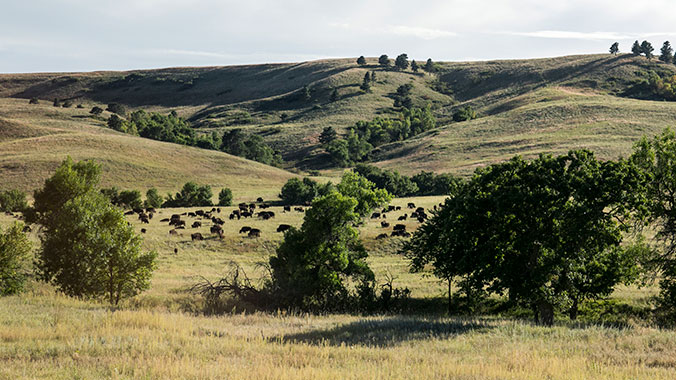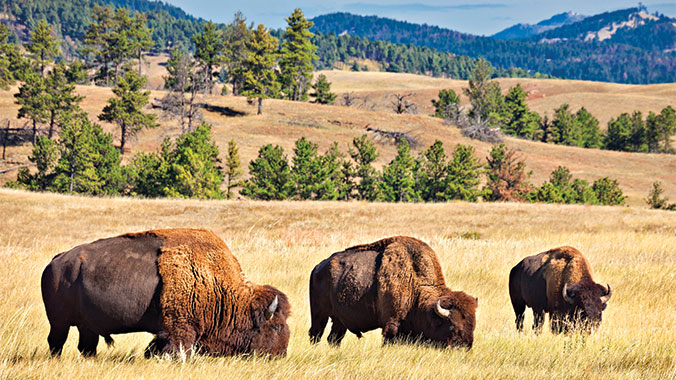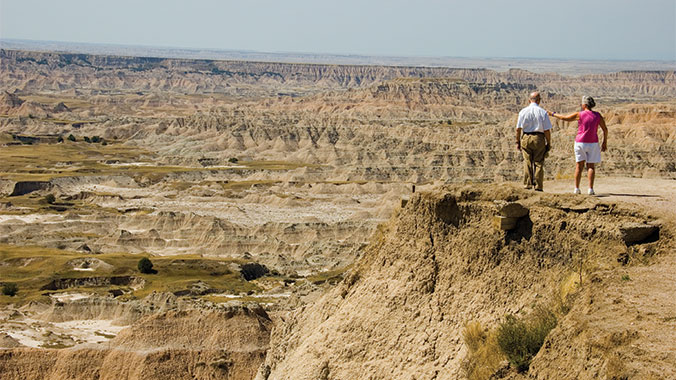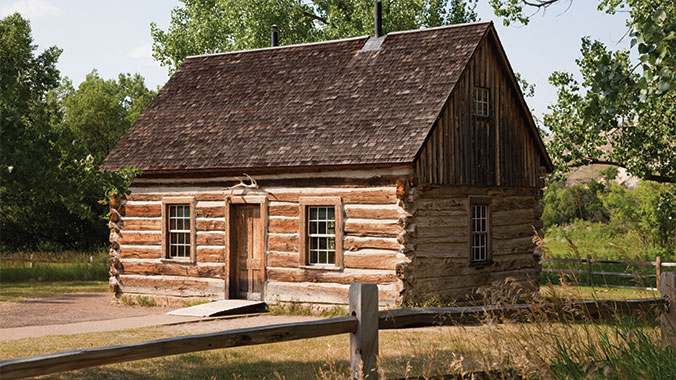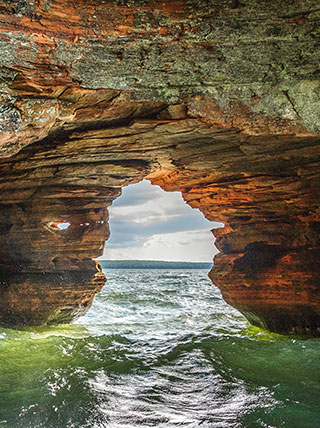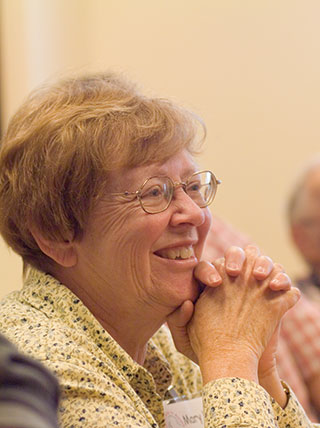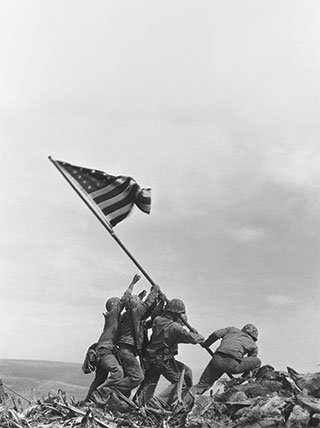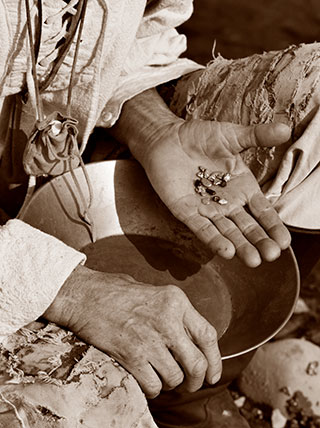South Dakota/North Dakota
Best of the Dakotas
Program No. 22815RJ
Watch for bison along winding roads in the Black Hills and take in moonscape views in the Badlands as you explore the history and heritage of the Dakotas from the Ice Age to today.
Enroll with Confidence
We want your Road Scholar learning adventure to be something to look forward to—not worry about. Learn more
Protecting the Environment
We offset a portion of the emissions created by your travel. Learn more
10 days
9 nights
22 meals
8B 7L 7D
1
Check-in, Orientation and Welcome Dinner.
Rapid City, South Dakota
2
Mount Rushmore, Crazy Horse, Rapid City
Rapid City, South Dakota
3
Stave Kirke Chapel, Custer State Park, Mammoth Site
Rapid City, South Dakota
5
South Dakota Capitol, Oahe Dam, Welk Homestead
Bismarck, ND
8
Theodore Roosevelt Park and Medora Musical
Medora, ND
9
Center of the Nation, Devils Tower National Monument
Rapid City, South Dakota
10
Program Concludes
Rapid City, South Dakota
At a Glance
The 60-foot faces of four U.S. presidents gaze out over the Black Hills. Recognized worldwide, Mount Rushmore stands as a symbol of American democracy. Experience this national icon and more as you explore the best of North and South Dakota, from the winding roads of the Black Hills to the other-worldly moonscapes of the Badlands. Visit national and state parks, memorials, monuments and museums as you discover the history and heritage of the Dakotas, from the Ice Age to the American Indian Wars. Learn about the influence of people like Lewis and Clark, Theodore Roosevelt, Sacagawea and Crazy Horse, and take in the splendor of the wide-open spaces of the western frontier.
Activity Level
On Your Feet
Walking up to two plus miles a day on mostly flat terrain, some climbing stairs and in and out of the motor coach numerous times a day.
What You'll Learn
- Visit world-renowned parks, memorials and monuments like Mount Rushmore, Custer State Park, Theodore Roosevelt National Park and Devil’s Tower.
- Learn about the history, culture and people of the Dakotas as you visit both states’ capitals, and find out more about the native and presidential history of the Badlands.
- Appreciate the massive metal art sculptures along the Enchanted Highway, and attend the Greatest Show in the West, The Medora Musical, featuring real horses, cowboys, song and dance.
General Notes
Select dates are designated for small groups and are limited to 24 participants or less.
Suggested Reading List
(6 books)
Visit the Road Scholar Bookshop
You can find many of the books we recommend at the Road Scholar store on bookshop.org, a website that supports local bookstores.
Best of the Dakotas
Program Number: 22815
Black Elk Speaks, The Premier Edition
"Black Elk Speaks" is widely hailed as a religious classic, one of the best spiritual books of the modern era and the bestselling book of all time by an American Indian. This inspirational and unfailingly powerful story reveals the life and visions of the Lakota healer Nicholas Black Elk (1863-1950) and the tragic history of his Sioux people during the epic closing decades of the Old West. In 1930, the aging Black Elk met a kindred spirit, the famed poet, writer, and critic John G. Neihardt (1881-1973) on the Pine ridge reservation in south Dakota. The Lakota elder chose Neihardt to share his visions and life with the world. Neihardt understood and today Black Elk is known to all.
Hunting Trips of a Ranchman and The Wilderness Hunter
"Roosevelt's sojourns in the Dakotas, Montana, and Wyoming had a powerful influence on his outlook and politics. Most of all, his time in the West brought him great joy. A joy that is apparent in every page of Hunting Trips of a Ranchman and The wilderness Hunter." --Stephen E. Ambrose <br><br>Written during his days as a ranchman in the Dakota Bad Lands, these two wilderness tales by Theodore Roosevelt endure today as part of the classic folklore of the West. The narratives provide vivid portraits of the land as well as the people and animals that inhabited it, ever underscoring the author's abiding concerns as a naturalist.
Six Wars At A Time
The book depicts the life and times of Gutzon Borglum (1867-1941), the sculptor of Mount Rushmore. Painter, sculptor, political crusader, city planner, aviation enthusiast, critic and sportsman. Gutzon Borglum threw himself into life as it was lived in the halcyon days of the turn-of-the-century. His life was filled with romance, adventure, accomplishment and intrigue. It touched every president from Teddy Roosevelt to FDR, the artists, statesmen, politicians and celebrities of his time in a story that led to its inevitable conclusion at Mount Rushmore.
The Journals of Lewis and Clark
The one-volume edition of "The Lewis and Clark Journey" is outstanding in every way. Edited by the late Pulitzer Prize-winning historian Bernard DeVoto the book gives the reader a fuller understanding of the Lewis and Clark expedition, 1804 to 1806, through the words of Meriwether Lewis and William Clark themselves. Follow the expedition from Saint Louis to the Pacific Ocean and back again which resulted in the initial exploration and mapping of the Great Plains and Pacific Northwest, the description and classification of over 100 never-before seen species of flora and fauna. In addition, the book dispels the myth of a northwest passage to the orient, and opens up the vast central and western regions of the continent to commerce with the United States.
Lost Bird Of Wounded Knee
In this significant work of history, Renee Flood movingly narrates the story of Lost Bird, who has become a symbol for thousands of children adopted away from their tribes and, indeed, for all people who have lost their heritage through social injustice, ignorance, and war. It tells the life story of an Indian baby girl found under her mother's frozen body after the Wounded Knee Massacre (1890) in what is now present day Pine Ridge Indian Reservation, South Dakota.
Standing Witness: Devils Tower National Monument, A History
The book is a history based on superintendents’ notes, monument archives, historical publications, and personal interviews. From a humble beginning as an eroded igneous intrusion, to the prestigious status as America's first national monument (1906), to the monument centennial anniversary celebration, the Tower has beckoned and captivated visitors. Rising 1,267 feet above the Belle Fourche River, the 867- foot rock Tower is one of the most conspicuous physiographic features of the Black Hills. Devils Tower National Monument lies at the western edge of the Hills, in the central- west portion of Crook County, Wyoming. To many American Indian tribes the Tower is not scenic, 12 Standing witness but sacred. Almost everyone, of any nationality, who visits the Tower experiences some sense of "other-worldliness," of a connectedness beyond the physicality of the rock— a sense of wonder, to be sure, but deeper and broader. The Tower evokes an emotional response from visitors, whether or not they have come in search of such an encounter.
Recommended For You


